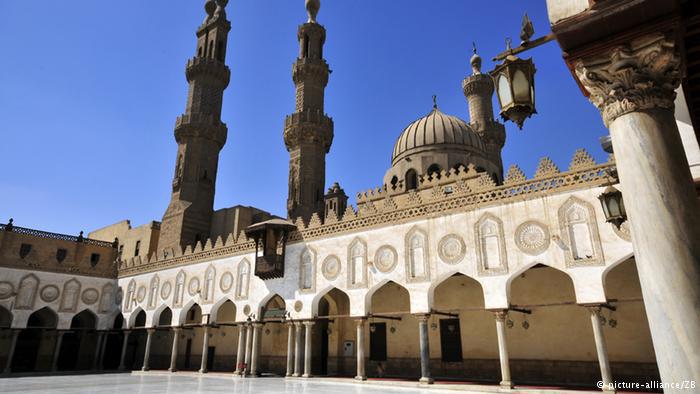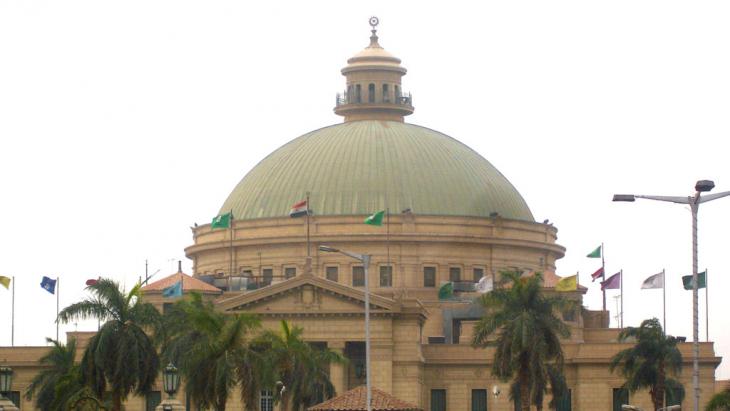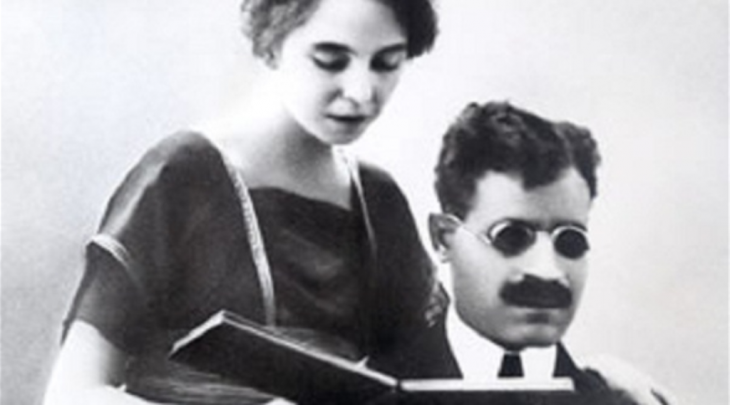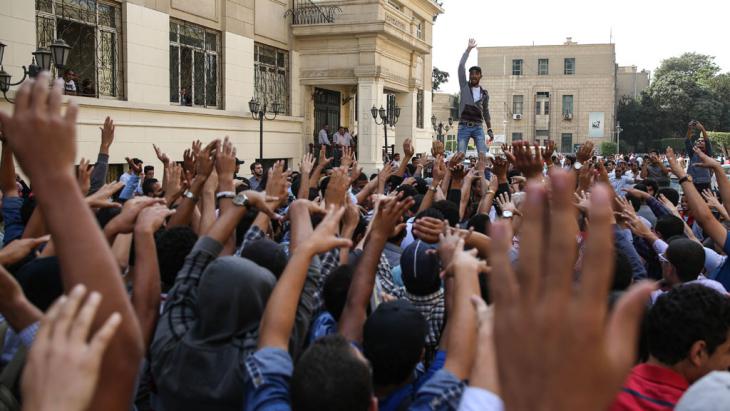The sea of knowledge

At the start of his autobiography "al-Ayyam", which was written in 1926 and is one of the best-known texts of Arab modernism, Taha Hussein describes the narrowness of the world as he perceived it as a young child:
"He was convinced that, on his right, the world ended at the canal that flowed past just a few steps away. Well, why not? After all, he couldn't see how wide the canal was, and couldn't gauge that a sprightly lad could leap across from one bank to the other; he couldn't imagine that there were exactly the same people, animals and plants on the other side of the canal as there were on this."
An eye condition had caused him to lose his sight when he was just a small child and had limited his horizon accordingly. However, it is not simply this physical impairment that the author is describing in his memoir. It is also a reference to the narrowness of the provincial village, the cultural and religious traditions and the restrictions of the rather poor life into which he was born in 1889, which gave rise to his yearning for the world "beyond the canal". Knowledge and education were to be his route out into the wider world.
His thirst for knowledge, which clearly stayed with him all his life, enabled him to break out of his narrow world. Thus the blind village boy grew up to become one of the most influential intellectuals of Arab modernism, who, as the author of plays and novels, the editor of influential newspapers, as a literary critic, university lecturer, and politician in the field of education has had a lasting influence on Egyptian and Arab intellectual life.
Obedience instead of debate
After attending the local Koranic school in the village, Taha Hussein followed in his older brother's footsteps at the age of 13 by going to study at al-Azhar University in Cairo. This, for him, was a great adventure – the blind boy's first step in his triumphal ascent. In the Egyptian metropolis he came to regard scholarship as a "boundless sea" and was seized by an unbridled enthusiasm for it. He was "determined to throw himself into this sea, to drink of its waters, as much as was granted to him, was even prepared to drown in them. What death would be more worthy of a noble man than one that befell him on the path to knowledge and was tantamount to drowning in scholarship?" he wrote in the second part of his autobiography.

However, his initial enthusiasm quickly gave way to disappointment over the narrowness of the teaching at al-Azhar. When he heard of the lectures by the reform theologian Muhammad Abduh (1849–1905), it opened up to him a whole new world of knowledge that made traditional teaching seem insipid and hollow. This did not envisage discussion, and was characterised not by freedom of scholarship but by strict hierarchy, obedience and indoctrination. Over time, his doubts about the teaching at al-Azhar continued to grow, and so did his new love of literature, which the Azhar scholars did not consider a serious subject.
Taha Hussein found a counter-model to their theological discourses in classical Arabic lyric poetry. He discovered "the difference between the crudeness of the Azharite taste and the refinement of the Ancients, […] between the dullness of the Azharite intellect and the critical judgement and artistic sensibility of the Ancients." In the third part of his autobiography he even speaks of a "soul-destroying boredom that caused him terrible anguish". (III, 9). The Azhar sheiks he had initially admired so much on account of their great knowledge increasingly became a deterrent and the objects of his hostility.
In their lectures, he remembered, "he always heard the same stale cliches and regurgitated, sterile lectures, which spoke neither to his heart nor to his taste nor to his intellect, and conveyed to him nothing new." Disappointed love soon turned into rebellion, and Taha Hussein, along with a couple of his friends, was expelled from the university.
He enrolled in the brand-new Egyptian University, and later became its very first graduate. At this university, founded in 1908 on the Western model in direct competition to the venerable al-Azhar, he became acquainted with a completely different form of learning. The professor giving the first lecture he attended seemed to him "as new and as strange as it is possible to be new and strange". He was utterly spellbound, and afterwards could barely sleep for excitement.
Later he idealised this period, writing that "Egyptian university life was an uninterrupted feast that the Egyptians celebrated night after night, however disparate their levels of education. Poor and rich, traditionally-dressed or in European clothes, they thronged the lecture halls." The Egyptian University becomes, in his recollection, a unifying school for the nation, bridging every divide, while al-Azhar is vilified for "torturing its spirit". The Egyptian University, however, was not the last stage of his ascent.

The West as both model and adversary
Taha Hussein's educational path then took him, in November 1914, on a scholarship to France, where he continued his studies over the next four years, first in Montpellier and later in Paris. Since the early nineteenth century, Arab literary figures had been challenged by the encounter with the West. They compared their own culture, religion and tradition with the modern Western world and debated the necessity of reform. Since – if not before – the report by Rifaa at-Tahtawi (1801–1873) on the study mission to Paris he headed from 1826 to 1831, the French metropolis had become the ultimate symbol of modern Western culture – also for Egyptian intellectuals. Tahtawi had approached Paris and its inhabitants with openness and sympathy and described the advantages and disadvantages of European society from a comparatively confident standpoint, presenting some things as exemplary and worthy of imitation; other things, which he clearly rejected, he declared inappropriate.
In the decades after Tahtawi, the relationship between the Arab-Islamic world and Europe became noticeably more tense. Against the backdrop of the very rapid increase in European power in the age of colonialism and imperialism and its oppressive military superiority, the debate on the Arab side became increasingly apologetic. Progress and modernisation were now increasingly reframed – by both West and East – as part of a European monopoly. An inverted counter-movement led to isolation reflexes: an emphasis on the otherness of their own, Arab culture, along with a withdrawal to what people regarded as their own identities and traditions.
Gamal al-Din al-Afghani (1839–1897) and Muhammad Abduh (1849–1905) called for the re-establishment of Islamic identity through a return to the pure origins of the religion, rejecting traditions that had developed over later years. However, there were some who had modern visions, too: at the turn of the century Qasim Amin (1863–1908) was already arguing in his books "Tahrir al-mar'a" (The Liberation of Women, 1899) und "al-Mar'a al-gadida" (The New Woman, 1901) against the separation of the sexes and in favour of the active participation of women in Egyptian society. As a precondition for this, Amin called in particular for a clear improvement in the educational situation of Egyptian women.

Taha Hussein's vision of a Mediterranean culture
Taha Hussein would later promote a similarly confident, aggressive stance towards modernism. Even before coming to France as a young man to study, he had immersed himself so deeply in European thought and European literature at the Egyptian University that the journey across the Mediterranean was not, for him, a journey to a foreign land. As a result, he did not feel any irreconcilable contradiction – let alone a "clash" – between the civilisations.
In his 1938 book on education policy, "Mustaqbal ath-Thaqafa fi Misr" (The Future of Culture in Egypt), he dismisses the contradiction between Western modernism and Eastern tradition – and with it the paradigm of supposedly, for Islamic societies, "foreign modernism". As he depicts it, there is no cultural divide between Egypt and Europe. On the contrary: they share a joint Mediterranean culture, which in the course of history has been formed equally by Greeks and Romans, by Jews and Phoenicians, by Arabs and Turks and Crusaders. Greek philosophy, Roman law and Abrahamite monotheism had, he said, shaped the culture around the Mediterranean – which for this reason should be seen as a bridge, not a frontier. The actual frontiers of this Mediterranean culture were marked by the Alps in the north and the Sahara in the south.
On the basis of this assertion, Taha Hussein called for the Arab inferiority complex in the face of the supposed superiority of the West to be overcome. He wrote that it was the Egyptians' duty, after achieving full independence, to establish a democratic system, modernise society, and in particular to "banish from their hearts the terrible and harmful fallacy that they were made of different stuff to the Europeans and endowed with a different intelligence." For him, education was the ideal way to achieve the goal of catching up with the Europeans (again) and becoming their equal partner.
Education as a path to modernism
The "Future of Culture in Egypt" is a decidedly programmatic cultural and educational policy statement by Hussein which should be viewed in the context of historical developments. Two years before it was published, in August 1936, Britain and Egypt had signed the agreement ending the occupation of Egypt, which had begun in 1882. Egypt's forthcoming independence raised questions about the country's future, especially about its cultural affiliation and national identity. Hussein's idealistic negation of the cultural differences between Europe and Egypt can be explained in this context. It was a time of new beginnings, and for Taha Hussein this meant, above all, a new beginning for the future of education. He believed that only if Egyptians – both men and women! – improved their educational situation would they be able to make the most of their potential and catch up with Europe.
At the time, many of his compatriots, as well as quite a number of European observers, shared Hussein's optimism. Khedive Ismail famously commented, on the occasion of the opening of the Suez Canal in 1869, that Egypt would become "part of Europe". The British writer and adventurer Richard Francis Burton underlined Ismail's optimism by noting his conviction, during his visit to Egypt in 1876, that highly satisfactory progress was being made. Burton's assessment was unequivocally positive: "Egypt must indeed, despite all predictions to the contrary, be seen as one of the most successful among the modern kingdoms." It was therefore "difficult to see any obstacle that could hinder its rise".

Educational reform
With the achievement of independence in 1936, the road towards a modern Egypt seemed clear. According to Taha Hussein, the prerequisite for this was a fundamental reform of the education system. The constitution of 1923 had already made it compulsory for Egyptians of both sexes to attend school, and had also made it a constitutional requirement for public elementary schools (al-makatib al-'amma) to be free of charge. However, the elementary schools that developed out of the Koranic schools (katatib) only offered a very modest basic education, whereas primary schools (madaris ibda'iya), which offered a modern education oriented towards the European system, still charged fees.
It was only through the primary schools that pupils were able to pursue the path to higher education, which would enable them to rise up through the ranks of officialdom. In this way, a two-tier system was established which cemented discrimination against the lower classes to the advantage of the middle class. In "The Future of Culture in Egypt", Taha Hussein was still arguing that elementary schools could be an adequate means by which the state could strengthen Egypt's national unity. However, during his time as an adviser in the Education Ministry, from 1942 to 1944, he was forced to acknowledge that the two-track school system was threatening to split society.
Efforts by the education minister of the day, Ahmad Nagib al-Hilali, to democratise the education system by abolishing school fees for primary schools were unsuccessful. When Taha Hussein himself became Minister of Education in January 1950, he continued to pursue the course Hilali had initiated and helped to push the measures through. He explained that education had to be as freely available to every child as "the water we drink and the air we breathe", and in 1950 he abolished school fees for secondary schools. In 1951, he combined the primary and elementary schools, extended them from four to six years, and in so doing created a standard primary school for all Egyptians.
These measures set a new course for educational policy in Egypt. However, it was to be a long time before the ideas were actually implemented. For quite a while, the reform existed only on paper, mainly because of a lack of finances, such that on the eve of the 1952 revolution, considerably fewer than half of Egyptians aged between six and twelve went to school at all. Furthermore, the level of the former elementary schools remained poor even after they were converted into primary schools, so that in many places the change amounted to nothing more than a change of name.
After the 1952 revolution, the new rulers resumed the overhaul of the education system. The focus of their efforts was on quantitative expansion, with the result that the qualitative improvement of the education system continued to lag behind – a problem which, not least as a result of Egypt's demographic development, remains unresolved today.
Andreas Pflitsch
© Goethe-Institut e. V., Fikrun wa Fann 2014
Translated from the German by Charlotte Collins